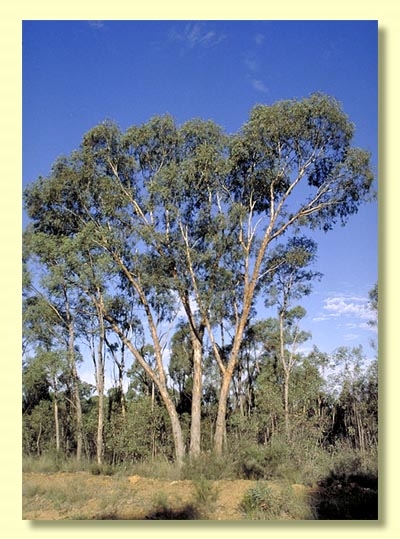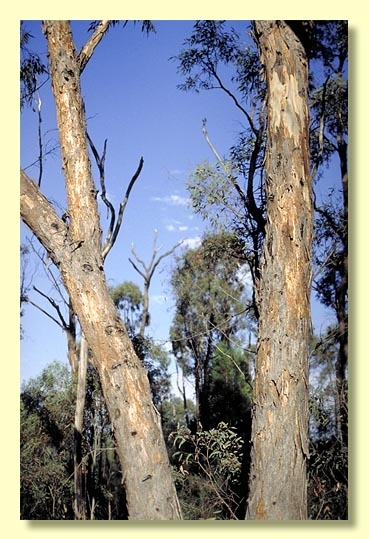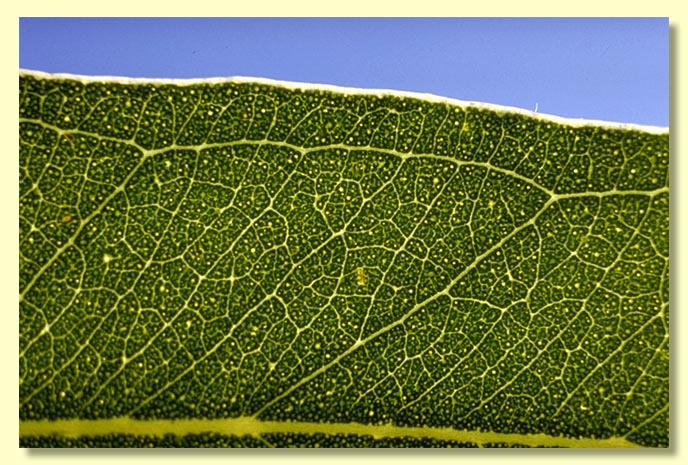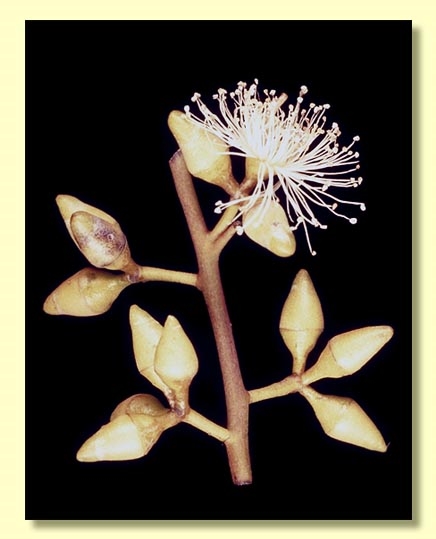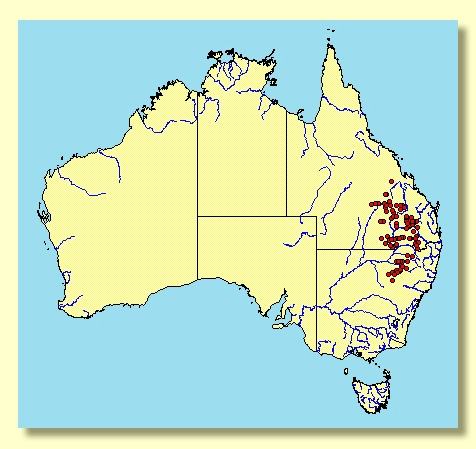Euclid - Online edition
Eucalyptus chloroclada
Eucalyptus | Symphyomyrtus | Exsertaria | Erythroxylon
In the southern part of the species range the trunk has a stocking of finely fibrous, flaky to box-type, grey or brown rough bark over part or most of trunk, whilst further north into Queensland the rough bark is much less developed and trees may lack rough bark altogether; smooth bark of upper trunk and branches white, cream, orange or grey mottled.
Juvenile growth (coppice or field seedlings to 50 cm): stems round or square in cross-section but not winged, sometimes weakly glaucous, smooth or slightly warty; juvenile leaves always petiolate, opposite for 2 or 6 nodes then alternate, lowest leaves ± orbicular, most leaves ovate, 5.5–15 cm long, 3–7.5 cm wide, green to grey-green or slightly glaucous.
Adult leaves alternate, petiole 1.5–2.5 cm long; blade lanceolate, 8.5–18 cm long, 1–3.5 cm wide, base tapering to petiole, margin entire, concolorous, glossy or dull, green to grey-green, side-veins greater than 45° to midrib, moderately to densely reticulate, intramarginal vein parallel to and well removed from margin, oil glands mostly island.
Inflorescence axillary unbranched, peduncles 0.5–1.2 cm long, buds 7 per umbel, pedicellate (pedicels 0.1–0.4 cm long). Mature buds ovoid to diamond-shaped (0.7–1.2 cm long, 0.3–0.6 cm wide), green or cream, scar present (outer operculum shed early), operculum conical (0.5–0.9 cm long), stamens few erect most inflexed or irregularly flexed, anthers cuboid to oblong, versatile, dorsifixed, dehiscing by longitudinal slits (non-confluent), style long, stigma tapered, locules 3 or 4, the placentae each with 6 vertical ovule rows. Flowers white.
Fruit sessile or pedicellate (pedicels 0–0.3 cm long), hemispherical, 0.2–0.5 cm long, 0.4–0.7 cm wide, disc level, valves 3 or 4, exserted.
Seeds dark brown to black, 0.7–1.3 mm long, pyramidal or cuboid, dorsal surface pitted, hilum terminal.
Cultivated seedlings (measured at ca node 10): cotyledons reniform to oblong; stems usually square in cross-section; leaves petiolate, opposite for 4 to 6 nodes then becoming alternate, ovate, 4–8 cm long, 2–5 cm wide, base rounded to tapering, usually green.
Flowering has been recorded in August, September, October, November and December.
A small to medium-sized red gum tree of the western slopes and plains of New South Wales particularly from the Pilliga northwards into the Texas, Cracow, Tambo, Dirranbandi area of south-east Queensland, usually occurring on deep sands low in the landscape. Eucalyptus chloroclada is a small to medium-sized tree with partly to wholly rough trunk in the south of its range but becoming ± smooth-barked in the north of its range; is non-glaucous except for the juvenile leaves; and has buds that are ovoid-diamond shaped whilst fruit have a flat disc with clearly exserted valves.
Eucalyptus chloroclada belongs to the group of red gums which is distinguished by having buds with the stamens mostly erect, fruit where the disc is united to the ovary roof and by the black, toothed, cuboid to pyramidal single-coated seed. Fifteen species belong to this group: E. amplifolia, E. blakelyi, E. chloroclada, E. dealbata, E. dwyeri, E. flindersii, E. gillenii, E. glaucina, E. infera, E. kabiana, E. nandewarica, E. nudicaulis, E. tereticornis, E. terrica and E. vicina.
Eucalyptus chloroclada and E. terrica are distinguished within this group by usually having thin, flaky to fibrous, orange-brown to brown rough bark on their trunks. All other species in this group are predominantly smooth-barked. However, large trees of E. tereticornis, E. blakelyi and E. dealbata can sometimes have accumulated rough bark at their base. E. chloroclada can be further distinguished from these by having a shorter operculum than those of E. tereticornis and a flat-topped fruit. E. dealbata can be further separated by having glaucous buds and young fruit. Conversely, specimens ascribed to E. chloroclada in Queensland can sometimes have smooth bark, and in this situation may also be confused with these three species and are distinguished as previously mentioned. E. terrica is a rough-barked species from the Warwick–Inglewood area of south-east Queensland. It is distinguished from E. chloroclada by its juvenile leaves, which are lanceolate to narrowly lanceolate compared with ovate in E. chloroclada.
Within its area of occurrence, E. chloroclada may be confused with another closely related rough-barked red gum, E. exserta. Both can be separated by the rough bark which is usually thicker and extends to the small branches in E. exserta but thin and only to the trunk and perhaps large branches in E. chloroclada, and by the juvenile leaves, which are normally linear to narrowly lanceolate in E. exserta (0.3–1.3 cm wide) but ovate in E. chloroclada (4–7.5 cm wide). In parts of Queensland, where the rough bark of E. chloroclada is less pronounced, it may also be confused with E. camaldulensis. E. camaldulensis is easily recognised by having yellow seed. If seed is not available, the two species can be separated by the disc of the fruit, which is prominently ascending in E. camaldulensis but flat to slightly ascending in E. chloroclada. In addition E. camaldulensis is usually restricted to heavier soils whilst E. chloroclada occurs on deeper sands.

